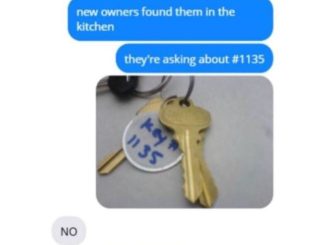Life is everchanging. It seems to become more chaotic the older we get and the more industrialized we as a society become. So, going into stores or malls isn’t as feasible as it once was. Consequently, online shopping has become more common, and in many cases, is the new normal.
Although online shopping is much more convenient, there are some downsides including the possibility of not getting exactly what you thought you were buying. Additionally, more intense downsides exist, such as safety concerns. To combat some of these concerns and ensure safety, Pembroke, Ontario, a small city in Canada, is using a handshake symbol as a new solution to ensure safety. Their idea, while unconventional, could prove to ensure the safety of thousands of shoppers. If proven successful, Pembroke may transform the way people undertake online shopping.
Handshake Symbols Represent Safety
A handshake symbol is showing up in parking spaces all over the city. Pembroke’s police department, Pembroke OPP, gave a statement regarding the new handshake symbol parking spots. “The purpose of Project Safe Trade is to create a ‘community safety zone’ at an OPP detachment parking lot to facilitate online property transactions,” the OPP said in the news release. “Creating a ‘community safety zone’ is about moving online transactions away from secluded parking lots, personal residences or other areas and bringing them to a public place.”
Parameters of the Project
Amazingly, the handshake symbol spots, called “safe trade spots,” will be available 24 hours a day and will not require appointments. The way these spots work is simple. If you’ve purchased something online but have to pick it up, or pay, in person, the handshake symbol spots become a neutral meeting point. It’s important to note these spots will not be monitored 24 hours a day. This means there will be no police intervention, such as mediation or witnessing a transaction. In contrast, they will have available officers on the scene if a call or complaint is made to the city regarding a criminal matter. The area will be well-lit and conveniently located just off the highway.
Holiday Shopping
With the holidays upon us, things become even more hectic, and people often stop looking into all the transaction details. The handshake symbol spots have been developed in tandem with the holidays. Steph Neufeld, the safety unit’s captain, says, “The local launch of Project Safe Trade comes at an ideal time with the busy holiday season upon us. Online property transactions are ever-increasing and the UOV OPP is proud to be launching a community safety initiative aimed at decreasing offences related to online marketplace transactions,” He continues in the statement, “Collaborative approaches like Project Safe Trade can help to reduce harm and victimization in our communities.”
Going Beyond the Handshake Symbol
The handshake symbol parking lots are a great start, but there is more the city has incorporated into the project. In particular, one Canadian resident and professional. Carmi Levy, a technology analyst, offers helpful hints. While seemingly obvious, they can be forgotten during an overwhelming time like the holidays.
Levy said, “Do your due diligence on the person that claims to be selling it. Look into their background, see what other things they’ve sold, look for information on how other buyers have dealt with them in the past.” Also suggesting people, “Insist on seeing the actual device that you’re buying before you hand over any money. Insist that they power it on. Insist that you make sure it works before you pay for it.” This is a great way to avoid being scammed and wasting your hard-earned money on something that just isn’t worth it.
Other Safety Suggestions
Other recommendations include going with someone you know and trust when engaging in online transactions. Save all interactions between buyer and seller, this includes voicemails, emails, or text messages. Additionally, shopping apps like ‘OfferUp’ and ‘LetGo’ tell you they won’t reach out for personal information. They suggest you use caution when doling out personal information with limited or only necessary information.
Furthermore, they suggest that you have those conversations strictly in the app. This ensures the conversation is logged in a secure environment so you can avoid giving your personal information to a stranger. For Canadian residents, specific to the Pembroke area, seeking handshake symbol parking lots can keep citizens safe this holiday season. Moreover, they can help bring higher levels of safety in years to come.
Here’s Why I Refused to Take Care of My Mother with Disability– Story of the Day

My mother had a clear favorite her entire life, while I was raised by my grandparents mostly. When she got old and sick, I helped financially but refused to do more than that for a crucial reason.
While most good parents would tell you that they don’t have a favorite, my mother was not ashamed to tell me that my brother, Stanley, was her golden boy. My father walked out of our family because caring for two children became too much.
In the end, my mother blamed me for it. “He wouldn’t have left if I hadn’t gotten pregnant with you,” she told me one day. I was just a child at the time and only wanted my mother’s love.
“But that’s not my fault,” I replied. “I didn’t ask to be born.”
“Don’t talk back to me! I’m the parent, and you’re the kid, so shut up,” she finished. We would have similar conversations through the years whenever she was mad at me. Finally, my mother sent me to live with my paternal grandparents.
They felt so bad that our father had walked away from our lives that they took me in and gave me all the love I never received at home. That’s how I learned that the word family has lots of meanings.
All I heard about my mother and brother over the years was that she helped him with everything. He got into some trouble with the police, and my mother paid all his legal fees. Eventually, she had to sell her house and pay for his apartment.
Stanley was spoiled and couldn’t hold down a job, but my mother coddled him. Meanwhile, my grandparents didn’t have much money, but they gave me everything they could. I had to work to afford my college and my home.
I learned a whole ton of responsibility, and when I graduated, I got a pretty decent job. That’s where I met my husband, Lawrence. We had two daughters whom I cherished equally. When my grandparents got sick, I was there for them until the very end.
They gave me their house, and one of my daughters moved there when she got married. Unfortunately, my husband died shortly after her wedding. She asked me to live with her, but I wanted to stay in our home.
I didn’t hear from my brother or my mother for many years. They didn’t care about me at all, so why should I care about them? But one day, Stanley called. “Hello?” I answered the phone.
“Hey, Brooke. It’s Stanley. How are you?” my brother said through the other line.
“Oh, hey, Stanley. Long time, no speak. I’m fine. How about you?” I replied.
“Yeah, it’s been a while. Listen, I’m calling because Mom broke her hip. I need your help,” Stanley continued.
“Oh, that’s too bad. Is she ok?” I asked.
“She’s fine. It’s just that the hospital bill will be pretty expensive, and I need help paying for it. She’s our mother after all,” he explained.
“Oh, well. Ok. Give me the details, and I’ll send some money,” I told him. My husband and I had accumulated decent savings, so I could afford to send Stanley some money for whatever our mother needed.
“That’s great, Brooke. Thank you. I’ll talk to you later,” Stanley said and hung up. I didn’t feel any obligation to my mother, but I wasn’t heartless. I sent him the money and forgot about it until a week later when my brother called again.
“Hey, Brooke!” Stanley started.
“Hey. How did everything go?” I asked.
“The operation for her hip went well, but the doctor just told me she’s going to need tons of rehab and round-the-clock care. I was wondering when you could come to pick her up?” my brother asked.
“What do you mean pick her up?” I probed, confused.
“I told you. She needs someone to take care of her. I’ve been by her side our whole lives. It’s time you take responsibility, Brooke. I can’t watch her,” Stanley added.
“Excuse me? Responsibility? Mom sent me to live with our grandparents because she hated me, and you were her golden boy. She essentially abandoned me,” I snapped.
“Please. Stop the melodrama. You need to step up because she needs you. She gave you life. You owe her,” Stanley demanded.
“No. I don’t owe her anything. I needed my mother when I was growing up, and she refused. She gave all her love to you, so you will need to figure out something. I gave you money for her hospital bills out of the goodness of my heart, but I won’t be her caretaker,” I told him.
“YOU’RE HORRIBLE, BROOKE! HOW CAN YOU DO THIS? I CAN’T WATCH HER!” Stanley started screaming through the phone.
“Honestly, I don’t care, Stanley. You don’t get to call me horrible. I was a kid when she abandoned me, and my grandparents became my REAL PARENTS. Don’t call me again!” I finished and hung up the call.
Stanley tried calling, texting, e-mailing, and more for several days, but I blocked him. He also tried contacting my daughters, but they refused to listen to him. They knew my history with that side of the family.
Of course, Stanley and my mother bad-mouthed me to anyone who would listen. I have been severely judged for my decision, but I didn’t listen to their criticism. After all, no one ever judged my mother for what she did to me.
What can we learn from this story?
- Caring for your loved ones is important. While Brooke’s choice is controversial, it’s easy to understand her point of view, given her background.
- Forgiveness is divine. Sometimes, you have to be the bigger person. Caring for your parents when they’re old is a big duty, both financially and emotionally. Someone has to do it.
Share this story with your friends. It might brighten their day and inspire them.
If you enjoyed this story, you might like this one about a mother who left her disabled daughter at an orphanage.



Leave a Reply